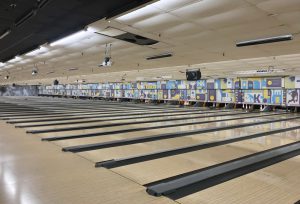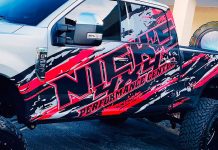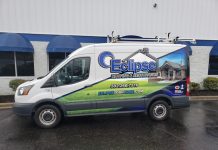 Efrain Yepes has opened his fair share of businesses over the past thirty-five year—gas stations, convenience stores, commercial real estate, etc. However, ten years ago, the recession caused him to instead search out a business opportunity he felt wouldn’t be affected by market forces.
Efrain Yepes has opened his fair share of businesses over the past thirty-five year—gas stations, convenience stores, commercial real estate, etc. However, ten years ago, the recession caused him to instead search out a business opportunity he felt wouldn’t be affected by market forces.
He noticed four things people see when they’re outside: other people, real estate, signs, and cars—lots of cars. “So I decided to open a business that serves two of those categories: signs and cars,” he says.
Yepes and his business partner, Production Manager Mario Quijano, launched Affordable Signs and Wraps in 2010, and the two haven’t looked back.
This Pinellas, Florida-based business truly is a “print” provider. The digital prints and wraps they produce constitute more than 70 percent of their total revenues, and they complement the remainder of their business by also offering full-color paper printing services.
The company designs and produces printed signs, vehicle graphics, banners, and window wraps for clients in the greater Tampa area and across the United States.
One reason they are successfully able to branch out with limited staff is because Yepes operates Affordable Signs and Wraps more as an agency, eschewing payroll altogether. They rely solely on company-only subcontractors to handle installations.
When he got started, Yepes noticed the wraps were really starting to take off, so he made sure that his shop was well equipped to handle such print loads to get involved in this field. They use a Roland TrueVIS VG-540 fifty-four-inch large format cutter/plotter, as well as a Roland VersaCAMM VS-540, on their shop floor.
For vehicle graphics, Affordable Signs and Wraps offers a range of options from lettering to full wraps for single vehicles, and 20 percent discounts for wrapping fleets of five or more vehicles. They are typically booked three to five weeks out.
 For clients that are just getting started, Affordable Signs and Wraps has developed an affordable signature partial vehicle wrap they call “26 Inches Down and Around” where two twenty-six-inch wraps are designed to blend in with the color of the vehicle and run from headlight to taillight on both sides.
For clients that are just getting started, Affordable Signs and Wraps has developed an affordable signature partial vehicle wrap they call “26 Inches Down and Around” where two twenty-six-inch wraps are designed to blend in with the color of the vehicle and run from headlight to taillight on both sides.
“Our fifty-four-inch printer allows us to print up to fifty-two inches wide. Twenty-six inches is half, so we print both sides together and there will be zero waste,” says Yepes. “This configuration covers the areas that are fully useable and doesn’t include window frames or the hood and roof (which aren’t as visible or don’t have enough area for content).”
Yepes doesn’t spend money on advertising; instead he feels that a customer being 100 percent satisfied is the best possible ad. “When a person sees one of our jobs, they’re always going to ask, ‘Who did that for you?’” he says. “So if we are able to impress our customer with the print quality and resolution, then we will have all their friends, family, and business acquaintances as potential customers too.”
Yepes just finished overseeing installation of Affordable Signs and Wrap’s largest wrap project to date—an 8-by-600-foot mural for a nearby sixty-lane bowling alley. The location had undergone a $1.5 million remodel, and the owners thought that a collage of oversized, abstract, bowling-related art over the lanes would really spruce things up.
The bowling alley owners hooked up with a graphic designer for this concept, and bowling alley owners supplied Yepes and Quijano with the finished artwork that had been conceptualized by another graphic designer in a vector format in Adobe Illustrator for output and install. “There were no photographs, which made resolution easier to work with in reproduction,” says Yepes.
Affordable Signs and Wraps printed out sixty panels onto non-translucent vinyl material. Thirty 38-by-120-inch panels were placed in a U-track at the top of each eight-foot-wide lane with thirty 48-by-120-inch panels below them. External LED lighting fixtures embedded within the steel frame add atmosphere to the graphics.
They added matte laminate to the graphics so as to prevent any light from creating a glare on the prints.
“To avoid starvation marks and maintain color accuracy as well as correct alignment, we printed each panel separately before installation on the wall,” says Yepes. “Even with the many panels we printed, the colors came out consistently and perfectly,”
Although the bowling alley mural required a lot of printing and smart scheduling, the project went smoothly. “The place looks absolutely beautiful,” says Yepes.
By Jeff Wooten with additional reporting by Ginny Mumm.










